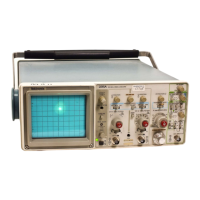Section 3—2215A Service
THEORY OF OPERATION
INTRODUCTION
SECTION ORGANIZATION
This section of the manual contains a general summary
of instrument functions followed by a detailed description of
each major circuit. A basic block diagram, a detailed block
diagram, and the schematic diagrams are located in the
tabbed “Diagrams" section at the back of this manual. They
are used to show the interconnections between parts of the
circuitry, to indicate circuit components, and to identify inter
relationships with the front-panel controls.
The schematic diagram number associated with each de
scription is identified in the text and is shown on the block
diagrams. For best understanding of the circuit being de
scribed, refer to the appropriate schematic diagram and the
two block diagrams.
INTEGRATED CIRCUIT DESCRIPTIONS
Digital Logic Conventions
Digital logic circuits perform many functions within the
instrument. Functions and operation of the logic circuits are
represented by logic symbology and terminology. Most logic
functions are described using the positive-logic convention.
Positive logic is a system of notation whereby the more pos
itive of two levels is the TRUE (or 1) state; the more nega
tive level is the FALSE (or 0) state. In this logic description
the TRUE state is referred to as HI, and the FALSE state is
referred to as LO. The specific voltages which constitute a
HI or a LO state vary between specific devices. For specific
device characteristics, refer to the manufacturer’s data
book.
Linear Devices
The functioning of individual linear circuit devices in this
section use waveforms or other techniques such as voltage
measurement and simplified diagrams to illustrate their
operation.
J
3-1

